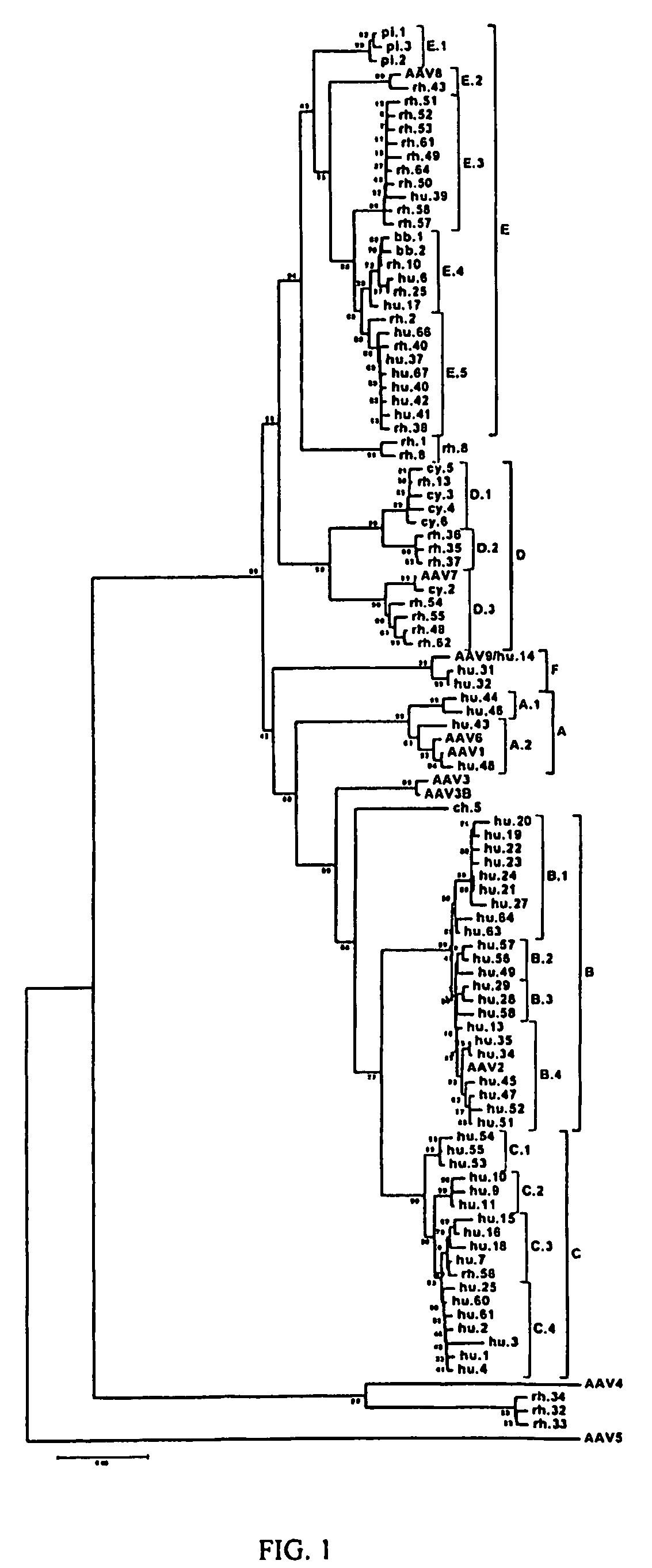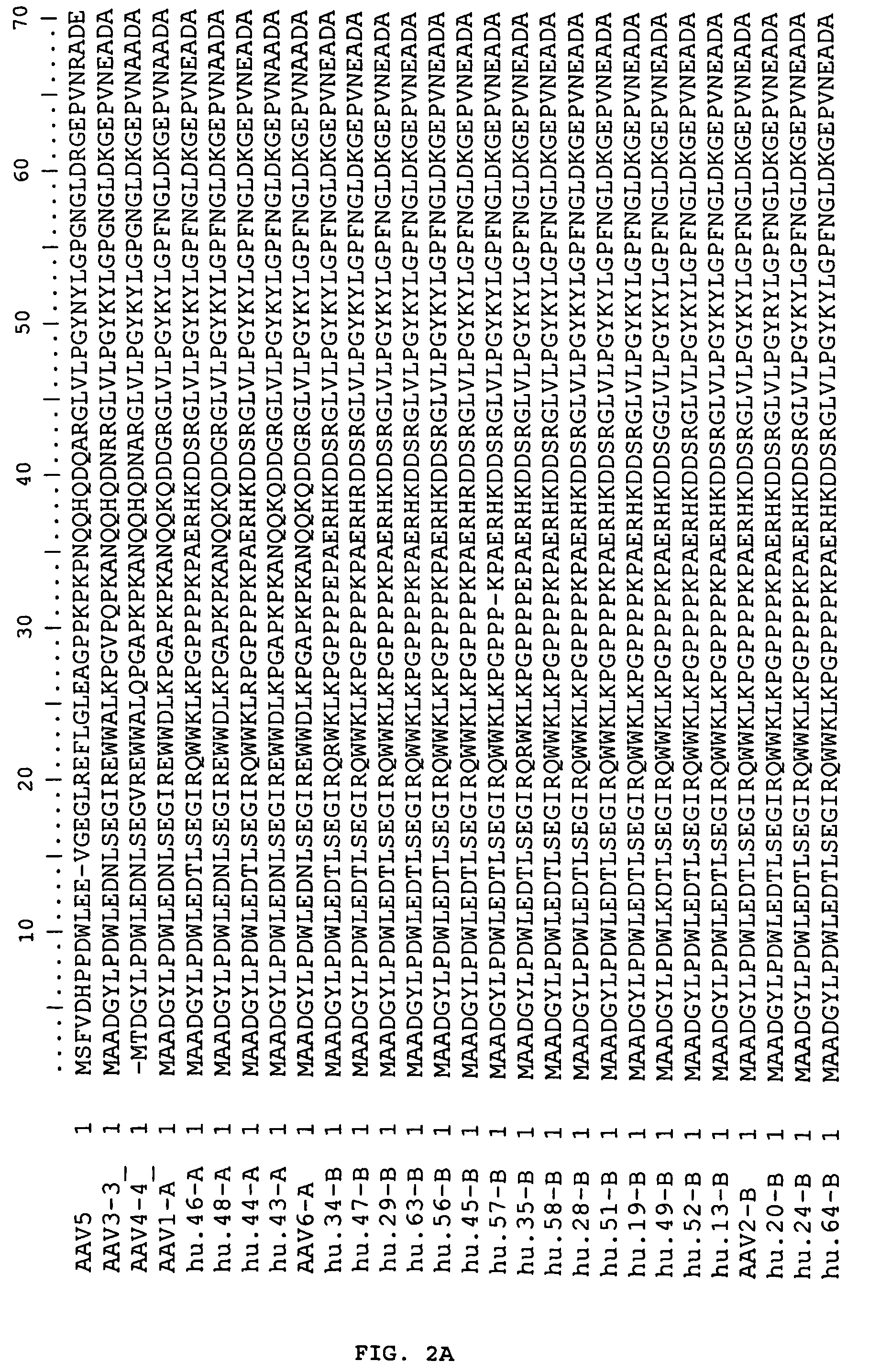Adeno-associated virus (AAV) clades, sequences, vectors containing same, and uses therefor
a technology of adenovirus and adenovirus, which is applied in the field of adenovirus clades, sequences, vectors containing same, and uses therefor. it can solve the problem that the relationship between these different serotypes has not been explored
- Summary
- Abstract
- Description
- Claims
- Application Information
AI Technical Summary
Benefits of technology
Problems solved by technology
Method used
Image
Examples
example 1
Computational Analysis of Primate AAV Sequences
[0192]A. Collection of Primate Tissues
[0193]Sources of nonhuman primate tissues were described previously [N. Muzyczka, K. I. Berns, in Fields Virology D. M. Knipe, P. M. Howley, Eds. (Lippincott Williams & Wilkins, Philadelphia, 2001), vol. 2, pp. 2327-2359]. Human tissues were collected from either surgical procedures or postmortem examination or organ donors through two major national human tissue providers, Cooperative Human Tissue Network (CHTN) and National Disease Research Interchange (NDRI). Human tissues used for this study were comprised of 18 different tissue types that included colon, liver, lung, spleen, kidney, brain, small bowel, bone marrow, heart, lymph nodes, skeletal muscle, ovary, pancreas, stomach, esophagus, cervix, testis and prostate. The tissue samples came from a diverse group of individuals of different gender, races (Caucasian, African-American, Asian and Hispanic) and ages (23-83 years). Among 259 samples fr...
example 2
Serological Analysis of Novel Human AAVs
[0205]The last lade obtained as described in the preceding example was derived from isolates of 3 humans and did not contain a previously described serotype. Polyclonal antisera were generated against a representative member of this lade and a comprehensive study of serologic cross reactivity between the previously described serotypes was performed. This showed that the new human lade is serologically distinct from the other known serotypes and therefore is called Clade F (represented by AAV9).
[0206]Rabbit polyclonal antibodies against AAV serotypes 1-9 were generated by intramuscularly inoculating the animals with 1×1013 genome copies each of AAV vectors together with an equal volume of incomplete Freud's adjuvant. The injections were repeated at day 34 to boost antibody titers. Serological cross reactivity between AAV 1-9 was determined by assessing the inhibitory effect of rabbit antisera on transduction of 293 cells by vectors carrying a r...
example 3
Evaluation of Primate AAVs as Gene Transfer Vectors
[0210]The biological tropisms of AAVs were studied by generating vector pseudotyped in which recombinant AAV2 genomes expressing either GFP or the secreted reporter gene α-1 antitrypsin (A1AT) were packaged with capsids derived from various clones and one representative member from each primate AAV clade for comparison. For instance, the data obtained from AAV1 was used to represent Clade A, followed by AAV2 for Clade B, Rh.34 for AAV4, AAV7 for Clade D, AAV8 for Clade E, and AAVHu.14 for Clade F. AAV5, AAVCh.5 and AAVRh.8 stand as single AAV genotypes for the comparison.
[0211]The vectors were evaluated for transduction efficiency in vitro, based on GFP transduction, and transduction efficiency in vivo in liver, muscle or lung (FIG. 4).
[0212]A. In Vitro
[0213]Vectors expressing enhanced green fluorescent protein (EGFP) were used to examine their in vitro transduction efficiency in 84-31 cells and to study their serological properties...
PUM
| Property | Measurement | Unit |
|---|---|---|
| volume | aaaaa | aaaaa |
| volume | aaaaa | aaaaa |
| phyusiologically compatible | aaaaa | aaaaa |
Abstract
Description
Claims
Application Information
 Login to View More
Login to View More - R&D
- Intellectual Property
- Life Sciences
- Materials
- Tech Scout
- Unparalleled Data Quality
- Higher Quality Content
- 60% Fewer Hallucinations
Browse by: Latest US Patents, China's latest patents, Technical Efficacy Thesaurus, Application Domain, Technology Topic, Popular Technical Reports.
© 2025 PatSnap. All rights reserved.Legal|Privacy policy|Modern Slavery Act Transparency Statement|Sitemap|About US| Contact US: help@patsnap.com



